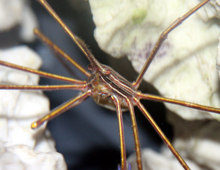Description: Arrow crabs, also known as Yellow line arrow crabs, have extremely long spider-like legs with deep violet tips, a triangular-shaped body and an extremely pointed head. The pointed rostrum (nose) is long and slender; eyes protrude on stalks. Decapods have 10 legs, eight for walking and two pincers (Chelipeds). Their body color is a medium golden brown with brown, black, yellow or gold stripes on their dorsal side.
Size: The carapace can reach lengths up to 2.4 inches (6 cm) and the legs can be more than three times its body length. Males are larger than females.
Behavior: Arrow crabs can be extremely territorial when threatened. They are nocturnal, scavenging for food at night and hiding during the day.
Diet: They scavenge the reefs for algae, worms (tube, duster and bristle), other invertebrates and dead organisms.
Reproduction: During mating, the male deposits a sperm packet into the female by holding her against his belly. The eggs are carried under the female’s abdomen until they hatch. The newly hatched young are called zoea and will retain this name throughout their larval stage of growth. During this time they
have rounded transparent bodies and live in open waters feeding on small plankton. As they grow through this stage they molt. Once they are done molting in the larval stage they enter into a new stage, megalops. It is during this stage that their body and limbs begin to have a crab-look form.
Habitat/range: They prefer rocky areas where they can hide, but they are also seen in sponges, the spines of urchins and under anemones. They are found along coral reefs from North Carolina and Bermuda to Brazil and throughout the Caribbean.
Status: Not Evaluated for IUCN Red List.



